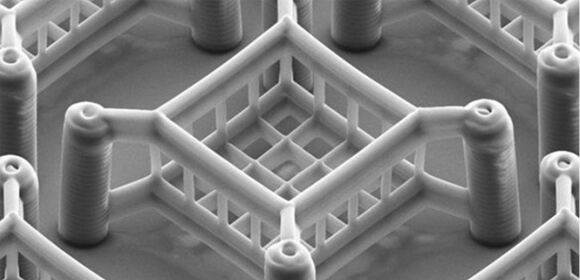-
Публикации
4290 -
Зарегистрирован
-
Посещение
Сообщения, опубликованные пользователем Saint
-
-
Анатомия Большого Брата
Датацентр Юты или тотальное наблюдение
http://www.looo.ch/2...tah-data-center
Очень интересная статья о том, как в США строят единую facility для слежки за всем интернетом. Очень деусексово.
АНБ хочет получить эксафлоп-компьютер уже к 2018-му году. Для этого в Оук Ридж построен т.н. Multiprogram Computational Data Center – цепь складов, начиненных вычислительными машинами, которые в сумме требуют 200 мегаватт энергии* и 60 тысяч тонн охлаждающего оборудования.В рамках $250 млн. контракта с Агентством Продвинутых Оборонных Исследований, Cray продолжает работать на АНБ, и обещает выпустить следующую версию «Ягуара», – на этот раз XK6 «Титан» со скоростью 10-20 петафлопс, – уже в 2013-м году. Гонка вычислительных скоростей продолжается. -
-
-
Да, тогда значит перезапуск.
Главгероя будут звать всё так же.
-
A 3D PRINTED SPACESHIP ON THE SCALE OF A HUMAN HAIR? HELLO NANOSCRIBE 3D PRINTER

3D printing has become one of the most exciting and talked about technologies of 2013. The ability for the masses to make almost any object not only fuels imagination but challenges modern consumerism and its supply chain. While some enthusiasts continue to showcase the technology by producing toys, cars, and even guns in their garage, others look to 3D printing to manufacture the next generation of electronics, whether for mobile applications, medical devices, or wearable computing.
Regardless of the application, the challenge in manufacturing at the submicron scale is fabricating structures in a precise, rapid, and consistent fashion. Even though 3D printing is just getting started, the race for the fastest, most capable printer is already on.
Last year, a group of researchers at the Vienna University of Technology in Austria refined a 3D printing technique that allowed the construction of sophisticated structures (an F1 racecar and a cathedral) smaller than dust mites in about 4 minutes. Now, a company called Nanoscribe GmbH that emerged from the Karlsruhe Institute of Technology in Germany has made a 3D printer called the Photonic Professional GT which can produce detailed structures on a similar scale but faster.
In fact, the technique was able to produce a spaceship (from the Wing Commander line of video games) from a CAD file that measures 125µm x 81µm x 26.8µm (on the order of the width of a human hair) in less than 50 seconds.
It really is an amazing feat that needs to be seen to be believed — remember: this video is in realtime!:
http://www.youtube.com/watch?v=wThtfAtB5U8
Ну и далее:
-
DXHR это тоже перезапуск?
Просто циферки уже не мейнстрим, теперь мейнстрим менять подзаголовок.
-
Deus Ex Human Revolution - 8 Bit Theme (3,7 MB)
(протегировал)
-
Восьмибитная тема DXHR, которую они юзали -- отсюда.
-
Почему футболка замылена?
-
Rewritable digital data storage in live cells via engineered control of recombination directionality
Abstract
The use of synthetic biological systems in research, healthcare, and manufacturing often requires autonomous history-dependent behavior and therefore some form of engineered biological memory. For example, the study or reprogramming of aging, cancer, or development would benefit from genetically encoded counters capable of recording up to several hundred cell division or differentiation events. Although genetic material itself provides a natural data storage medium, tools that allow researchers to reliably and reversibly write information to DNA in vivo are lacking. Here, we demonstrate a rewriteable recombinase addressable data (RAD) module that reliably stores digital information within a chromosome. RAD modules use serine integrase and excisionase functions adapted from bacteriophage to invert and restore specific DNA sequences. Our core RAD memory element is capable of passive information storage in the absence of heterologous gene expression for over 100 cell divisions and can be switched repeatedly without performance degradation, as is required to support combinatorial data storage. We also demonstrate how programmed stochasticity in RAD system performance arising from bidirectional recombination can be achieved and tuned by varying the synthesis and degradation rates of recombinase proteins. The serine recombinase functions used here do not require cell-specific cofactors and should be useful in extending computing and control methods to the study and engineering of many biological systems.
-
А на SoundCloud нету этого?
-
ImDRUNK
Saints Row: The Third пройди, расскажешь как оно.
-
-
Star Citizen -- единственное в жанре, достойное сейчас упоминания.
-
Для угоревших по neo80's:
-
"Исторя рыцаря" (A Knight's Tale).
RIP Heath Ledger ;_;

-
В каком смысле "пока"? Их по 3 в сезоне.
-
Начал смотреть и... господи, как эпично.
Ещё бы, у каждой серии бюджет по 5-10 млн долларов.
-
The developer explained its plan for a fascinating translation system in a (fittingly translated) YouTube interview. Here’s the gist, via Cyberpunk’s forums:
“As of yet no decisions have been made, but we’re thinking about a system that could tell the world’s story. The idea is to record everything in original languages, i.e. if we’ll meet Mexicans in the game, they’ll be taking – Mexican slang even, portrayed by Mexican actors. The player would be able to buy a translator implant, and depending on how advanced it is, he’ll get better or worse translation.”“You can’t reliably recreate street slang of Los Angeles or some other American city, you can’t simply dub it and reproduce those emotions, rhythms of speech, mannerisms. Everything has to be cohesive. Otherwise we’d simply hear that Polish actors are trying to imitate Americans. That won’t work.”
-
Трейлер второго сезона (который уже вышел) без спойлеров.
-
Книжка слишком жидкая, лучше сериал смотреть.
-
Мне лень. Внештатником стать никто больше не хочет?
-
Вызов человечеству.
-
Вспомнил, у меня же Warhead непройденный.




Впечатления от игры
в Deus Ex: Human Revolution
Опубликовано:
Люсьен Дварковскиw,
пора браться за Project 2027 значит.